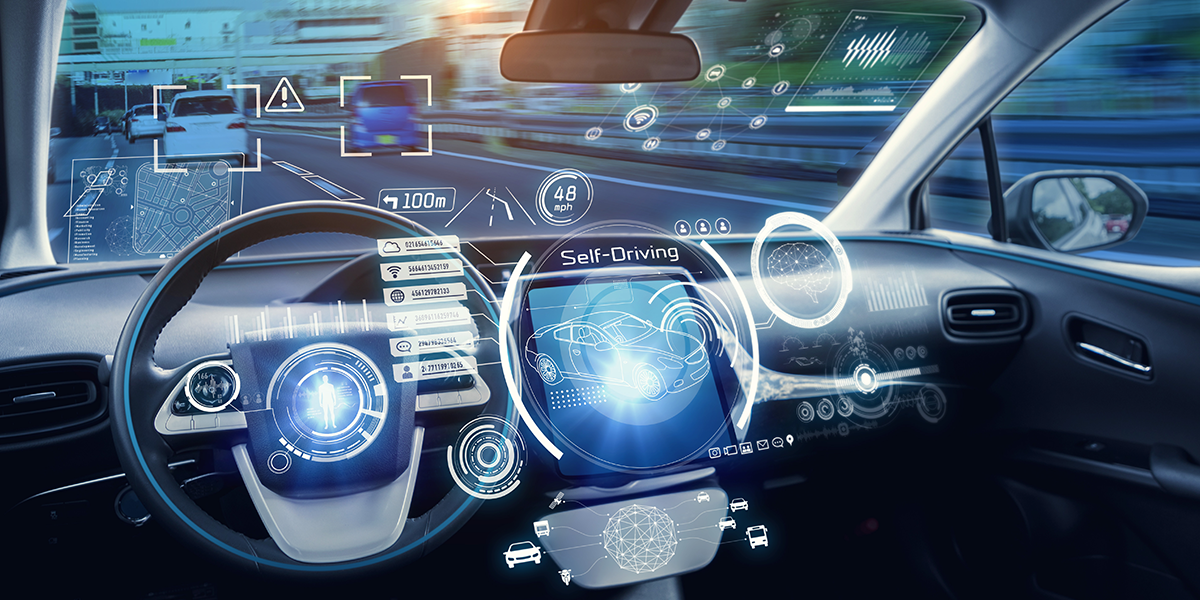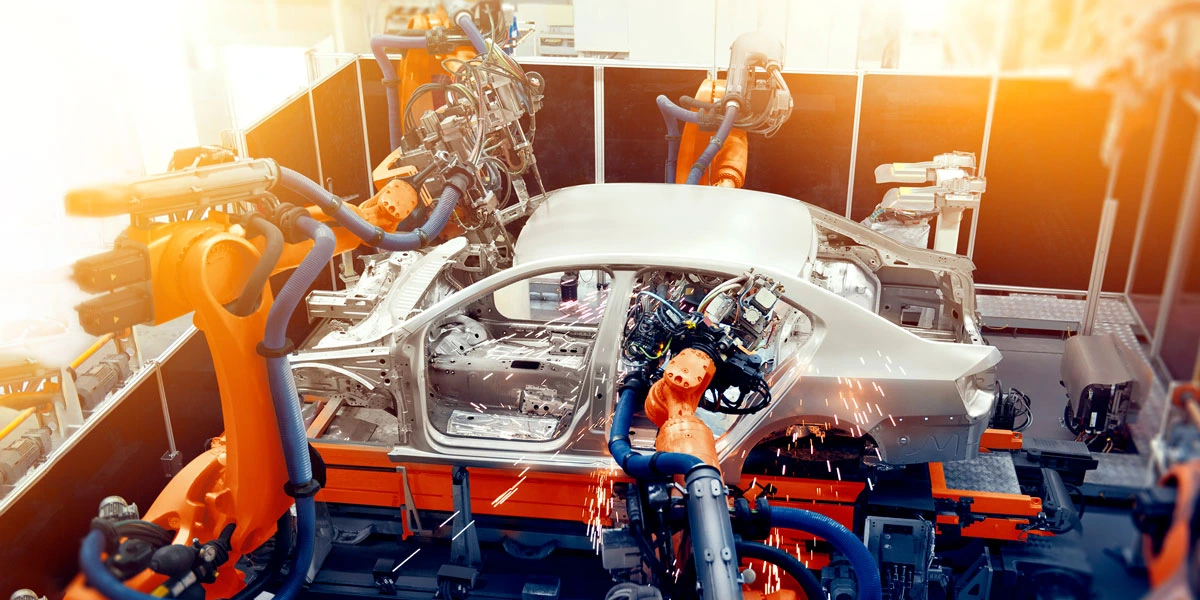AI in automotive: how intelligent systems are reshaping the future of mobility

Highlights:
Highlights
- AI is reshaping vehicles into intelligent mobility platforms, enhancing everything from safety systems to in-vehicle experiences.
- Autonomous driving represents the most complex frontier, requiring ongoing innovation in perception, prediction, and decision-making.
- AI-powered driver assistance systems (ADAS) are already reducing accidents through real-time detection and intervention.
- Predictive maintenance and digital twins are optimizing vehicle health and transforming automotive manufacturing processes.
- AI has the potential to enable greener, more connected transportation, supporting sustainable mobility and smarter urban planning.
The automotive industry is shifting gears faster than ever, and it’s none other than artificial intelligence that’s at the wheel. From predictive safety systems to cars that can make life-or-death choices in the time it takes for your eye to blink, AI is turning cars into intelligent mobility solutions. But it’s not all about self-driving cars. AI in automotive is making everything from gas mileage to real-time maps better, revolutionising the future of mobility.
Read our blog to learn how AI is revolutionizing transportation, making roads safer, enhancing the driving experience, and even changing the very definition of car ownership.
The evolution of AI in automotive development
The inclusion of artificial intelligence within cars is one of the most important technological transformations in the history of automobiles, parallel to the switch from horse-drawn carriages to motorized travel. AI within automobile systems has moved from plain rule-based applications to advanced neural networks that could deal with intricate, non-linear real-world situations.
Early uses of AI in automotive started with simple driver aids such as anti-lock braking systems and electronic stability control. These technologies used simple algorithms instead of real machine learning but set the standard for computers assuming active roles in car operation.
With computing power doubling exponentially in the early 2000s, more sophisticated implementations became viable, enabling developments like real-time vehicle system monitoring, predictive maintenance, battery health management, and advanced driver assistance features.
The actual AI breakthrough for car applications thus occurred when three key technologies came together: high-definition sensors, high-performance onboard computing, and sophisticated machine learning algorithms. This combination allowed cars to start sensing their surroundings with unprecedented precision. It also enables cars to process huge amounts of sensor data in real-time, making more advanced decisions from that data. Today’s cars feature dozens of microprocessors controlling everything from engine function to entertainment systems, providing a distributed computing platform well-suited to AI deployment.
The global automotive AI market has accelerated at an unprecedented rate, estimated to reach about $74.5 billion by 2030 (from $2.49 billion in 2019). This statistic underscores the potential benefit of AI in automotive tech as well as the competitive imperative of building these capabilities to stay ahead in the industry. Those firms that develop these technologies early will probably set industry standards for the next several decades.
1. Autonomous driving: the ultimate AI challenge
The most prominent and far-reaching use of AI in automotive design is arguably autonomous driving. Autonomous technology is perhaps the most daunting artificial intelligence challenge of our era, enabling machines to make life-or-death decisions in infinitely complex surroundings with near-flawless reliability.
Autonomous cars are based on an advanced AI framework that starts with perception—what’s out there in the world around you. Computer vision software interprets data from cameras, radar, LIDAR, and ultrasonic sensors to build a holistic representation of the world around the vehicle. These sensors have to detect everything from other cars and pedestrians to lane dividers, traffic lights, and possible obstacles, both day and night, in all weather.
Decision-making in real time
The decision-making aspects of self-driving cars are yet another territory for AI in automotive engineering. Once they see the world around them, they have to predict the actions of other road participants, compute ideal routes, and decide on responses by the car in a split second. Specialized neural networks trained on countless driving situations and fed with millions of examples utilize this process for both everyday routine and unusual “edge cases” that may not be seen for thousands of driving hours.
Despite significant strides in how AI in automotive is shaping autonomous driving, the significant risks associated with it cannot be ignored. These include software reliability issues, unpredictable system failures and lack of human-like judgment in ambiguous scenarios. Other concerns are maintenance challenges with outdated models, and broader systemic impacts like traffic disruption.
With great advances having been made, completely autonomous cars that can drive in all situations without human oversight are still a challenge that lingers. The difficulty in dealing with edge cases. Improvement in these areas is needed in both sensor technology and the sophistication of algorithms, where AI in automotive research continues to accelerate.
Read more: Performance of autonomous cars to rely heavily on automotive sensor-cleaning technology
2. Advanced driver assistance systems: AI on the road today
While self-driving cars keep advancing, AI in car safety is already having a significant influence through Advanced Driver Assistance Systems (ADAS). They are the most prevalent type of AI in automotive, with functionalities such as adaptive cruise control, lane-keeping aid, automatic emergency braking, and blind-spot detection becoming commonplace in new vehicles.
The efficiency of AI-based ADAS is derived from its capability to be ever vigilant in ways human drivers are not. The complexity of AI in car ADAS keeps growing, with systems moving from reactive to more predictive. Early ADAS would react to imminent threats—engaging brakes when an obstacle came into view straight ahead.
The shift from reactive to predictive safety
Current systems can predict possible hazards by studying traffic flows, anticipating pedestrian behavior, and even evaluating driver attentiveness through eye monitoring and steering input analysis. The Insurance Institute for Highway Safety (IIHS) found that front collision warning systems, when they were used along with automatic emergency braking, decreased front-to-rear crashes by 50% and front-to-rear crashes with injuries by 56%.
Artificial intelligence (AI) is a key driver in improving different elements of automotive driver assistance systems by facilitating instant data processing and decision-making. These are some of the most important features in AI in automotive for driver assistance:-
- Adaptive Cruise Control (ACC)
- Lane Departure Warning (LDW) and Lane Keeping Assist (LKA)
- Automatic Emergency Braking (AEB)
- Blind Spot Detection (BSD)
- Traffic Sign Recognition (TSR)
- Driver Monitoring Systems (DMS
Integration is a key area for future development for ADAS engineering. Rather than being stand-alone systems, AI in automotive through vehicle driver assistance now permits different ADAS subsystems to share information and coordinate responses. This systems-thinking approach enables higher-level intervention and more fluid execution, improving safety performance and also driver acceptance.
2. The connected car: AI and vehicle communication
Connectivity is revolutionizing AI in automotive technology, making vehicles smart, interconnected systems instead of standalone machines. Contemporary automobiles are not merely units on the road. They are becoming interconnected components of a broader digital universe, continuously sharing information with infrastructure, other vehicles, and cloud networks to provide improved safety, efficiency, and overall driving cognition.
Vehicle-to-everything, or V2X, communication is one of the strongest developments in this arena. By exchanging information with traffic lights, road surfaces, and surrounding vehicles, AI systems become more aware of the driving world. Vehicles are able to be warned in real-time about road threats, shifting traffic patterns, and impending congestion—all far more than their own sensors can perceive. This greater awareness is particularly useful for autonomous vehicles, which use predictive intelligence to foresee threats that are not yet visible.
In December of 2016, Audi launched the first such Vehicle-to-Infrastructure (V2I) technology in America, beginning with certain 2017 Audi A4, Q7, and allroad® models in Las Vegas. In its Traffic Light Information system, vehicles were able to get real-time signal information from the traffic management infrastructure in the city—by showing countdowns to green lights in the dashboard directly.
Smarter through the cloud: AI in the network
Cloud computing is central to AI in automotive networks, enabling vehicles to tap into immense computing capacity and collective intelligence. While onboard systems make life-or-death driving decisions immediately, cloud-based AI can operate on large-scale patterns, update code in real-time, and enhance algorithms across a whole fleet.
The capability to continuously improve AI models means vehicles become progressively more intelligent over time, learning to cope with new driving situations and improving road infrastructures.
Cloud vendors such as AWS (AWS IoT FleetWise), Microsoft Azure (Azure Connected Vehicle Platform), and Google Cloud enable over-the-air updates, fleet learning, and processing of large volumes of data.
Split-second decisions: The edge computing advantage
Edge computing is the other critical part of networked AI systems, finding a middle ground between cloud-based smarts and real-time response. Rather than depending entirely on remote cloud servers, edge computing handles data closer to the vehicle itself, providing split-second decision-making without delay. This solution enables AI to maximize performance without risking latency while still enjoying the benefits of centralized computing.
Products such as NVIDIA DRIVE, Qualcomm Snapdragon Ride, and Intel’s Mobileye provide robust edge AI platforms designed specifically for the auto industry. Modern use cases include Tesla’s Autopilot, which has real-time decision-making at the edge, with concurrent data being sent to the cloud to optimize neural networks.
As more cars become powered by artificial intelligence, they are transforming the very concept of mobility. A vehicle is no longer merely a private means of getting around. It is becoming a smart, networked appliance that works within an ever-changing environment. This transformation is not just enhancing personal driving experiences. It is setting the stage for safer, smarter, and more efficient cities.
3. Predictive maintenance and vehicle health
AI in automotive is not merely revolutionizing the way we drive. It is redefining the way cars are serviced and maintained. Rather than waiting for a component to go out or following standard maintenance schedules, AI-driven predictive maintenance enables vehicles to diagnose themselves on the fly. Through inspection of fine-grained patterns in sensor readings, AI can catch issues before they ever result in breakdowns.
This transition from reactive to predictive maintenance is a game-changer. Conventional maintenance depends on timetables or waiting for something to go wrong. But artificial intelligence scans through thousands of datapoints—engine condition, vibration profiles, fluids, and electrics to recognize signs of developing trouble.
For commercial fleet operators, the effect is even larger. AI in automotive systems enables fleet operators to optimize vehicle availability, conducting maintenance just in time rather than adhering to rigid service schedules. This precision saves money, reduces downtime, and keeps vehicles on the road earning money rather than waiting in the repair shop.
Fleet-level optimization and ROI in action
One compelling real-world example is Uptake Fleet, which assists commercial operators such as United Road in lowering maintenance expenses and increasing uptime with AI-based insights. Through the combination of sensor data and work order history, Uptake sifts through thousands of alerts to leave only the most critical ones. It therefore prevents surprise breakdowns and optimizes fleet efficiency.
In the case of United Road, this resulted in a 4x ROI, demonstrating how AI can convert raw data into street-level decisions that have a direct impact on operations.
AI-based vehicle health monitoring is becoming even more intelligent. Current systems are able to distinguish between actual problems and harmless variations due to driving conditions. This minimizes false alarms while still detecting potential failures before they occur. This translates to fewer unnecessary trips to the garage and greater faith in vehicle reliability. As AI in automotive technology advances, the future of car maintenance is less of a guessing game and more of a proactive, data-based approach that keeps cars running with minimal downtime.
4. Personalized in-vehicle experience
The cabin experience is now not just about leather upholstery and high-end infotainment displays. AI is making contemporary cars in highly customized environments that can adjust to your taste, read your mind, and perhaps even pick up when you are having a bad day.
Smarter voice assistants that truly get you
Remember those first voice assistants that had you say ‘Play my driving playlist’ five times before playing the wrong song? AI in automotive technology has advanced a lot since then. Due to natural language processing, today’s in-car assistants can comprehend conversational speech, identify various accents, and catch context. Whether you are requesting directions, changing the temperature, or simply complaining about traffic, your car’s AI assistant is listening a lot better these days.
In addition to essentials such as Apple CarPlay, Android Auto, and Google Assistant, names such as Cerence are reshaping the in-vehicle conversational experience.
Cerence creates voice assistants designed specifically for automotive and transportation. Its platform leverages automotive-specific language models (CaLLM™) and can deploy both in the cloud and embedded (edge). The system supports multi-turn dialogue, sophisticated tasks, and multiple speakers. Drivers can use voice, touch, or gestures naturally, even without connectivity, with Cerence xUI. It minimizes screen dependency, which aids in reducing distraction and cognitive load.
Your car recognizes you more than you realize
AI in automotive systems can recognize various drivers and customize settings without human intervention—no more fiddling with the seat and mirrors after someone else has used the vehicle. It can optimize anything from climate control to song selection so that your driving experience is always optimal. Certain systems even try emotion recognition, with cameras and microphones sensing stress or fatigue. If your vehicle recognizes you’re in a frazzle, it may dim the lights, play soothing music, or even recommend taking a break. No judgment—just a touch of AI-infused self-care.
BMW‘s new-generation Panoramic iDrive and Intelligent Personal Assistant go one step further. Driver profiles are associated with facial recognition and automatically turn on personal preferences. This ranges from lighting, drive mode, and display themes to infotainment shortcuts and even ambient sound. With the likes of My Modes and Panoramic Vision, the car dynamically adjusts the cabin atmosphere to your mood—relaxed, sporty, or concentrated, without you having to lift a finger.
Intelligent safety, adapted to your way of driving
The Volvo EX90, the company’s all-electric flagship SUV features Smart Eye’s high-end Driver Monitoring System. It employs two in-cabin cameras and AI algorithms to monitor the driver’s eye, face, head, and body movement in real-time. When paired with a capacitive steering wheel, the system identifies distraction, drowsiness, or unstable behavior. It provides timely warnings or interventions—without intrusiveness. Through this standardization of AI-based Driver Understanding System, Volvo is creating a new standard for intelligent safety that evolves based on how individuals drive.
No one drives exactly like anyone else, and AI in automotive technology is getting safety systems to be more responsive. If you’re a defensive driver, your vehicle may warn you sooner of impending dangers. If you’re a more aggressive driver, it may refrain from the incessant warning, sparing you the digital version of a backseat driver. This sort of customized intervention makes AI-driven safety features work better—and annoy less.
AI in automotive systems is not only about making automobiles intelligent. It is about making them more intuitive, more comfortable, and, let’s face it, much more fun to drive. The future of automotive AI is not so much about a cold, robotic system and more about a smart, thoughtful co-pilot that gets you.
Manufacturing transformation through AI
Besides redesigning the cars we drive, AI is also transforming how they’re made. From more intelligent quality control to completely optimized production lines, AI in automotive is making car manufacturing a high-tech, hyper-efficient process that is faster, wiser, and more accurate than ever.
Leave behind outdated assembly lines where human inspectors spent years perfecting their eyesight to detect defects. Computer vision technology driven by AI now scans components with virtually flawless precision. This detects even the most minute blemishes that human eyes would not notice. These machines never tire, are never distracted, or overlook a defect because it is the end of a long workday. They work around the clock. By verifying hundreds of details simultaneously, this technology guarantees that every component meets the highest quality standards while creating useful data to further optimize production processes.
But the influence of AI in automotive technology extends beyond quality control. Predictive analytics is providing manufacturers with a sixth sense for impending disruptions. This allows them to coordinate supply chains and production schedules with unprecedented effectiveness. By scrutinizing real-time data against historical patterns, AI can alert oncoming equipment failures even before they occur. They can also notify on impending supply chain bottlenecks, and tweak production plans in real-time. In an age where one supply chain glitch has the potential to destabilize an entire industry, such prescience is a game-changer.
Then there is the rise of digital twins. They are virtual replicas of manufacturing systems that allow engineers to test changes before making real-world adjustments. These AI-powered simulations make it possible to fine-tune production lines, identify bottlenecks, and optimize workflows without ever touching a physical machine. Want to see how a change in assembly speed affects overall efficiency? Simulate it. Need to test a new process without shutting down production? Digital twins enable that.
AI is making car manufacturing a smart, self-optimizing system resulting in better-quality cars, reduced production downtime and lower expenses. The factory floor of the future is not only automated—it is smart, learning in real-time, and continually optimizing.
A greener path forward?
Transportation alone generates roughly a quarter of world-wide greenhouse gases, but there is a silver lining in sight. AI is enabling mobility systems to be wiser, saving resources, better matching energy supplies to demand. This transforms the future of the automotive industry into a much smoother, much less toxic proposition.
AI in automotive is accelerating electric cars by optimizing battery life, streamlining charging strategy, and delivering more precise range estimates. The payoff? Reduced expenses, fewer emissions, and optimized energy use at scale.
The way we drive is also being upgraded. The typical private car is in park 95 percent of the time, a completely inefficient use of space and resources. AI-based ride-sharing and vehicle-pooling platforms are transforming that by linking riders. This lowers the number of vehicles on the road, and decreasing congestion without losing convenience.
Online shopping is booming, and so is delivery traffic. But AI in automotive is working to make logistics businesses reduce their carbon footprint. Intelligent route optimization considers the state of traffic, vehicle capacity, and urgency of delivery. This helps cut back on non-essential mileage and fuel use.
AI in automotive isn’t simply repairing what already exists on the road. It is assisting city planners with designing smarter, more sustainable transportation systems from scratch. Through travel pattern analysis, land use planning, and population trends, AI informs choices about where to locate transit hubs, bike paths, and public transit infrastructure. This decreases car reliance, increases mobility options, and assists cities in preparing for an environmentally and economically viable future.
The future
The future of AI in automotive technology is only beginning. As development advances, a number of trends will shape the future of smart transportation. This is what’s to come:
- Sharper, smarter sensors – Car vision is on the cusp of an upgrade. Look for improved-resolution cameras, more accurate radar, and less expensive but more sophisticated LIDAR systems. Solid-state LIDAR is most exciting—it dumps huge mechanical elements, making it more reliable, power-efficient, and cost-effective. That translates to AI-driven cars “seeing” the road more acutely than ever.
- Faster, more efficient AI processing – Executing sophisticated AI models within a vehicle is no trivial accomplishment. Processing chips designed exclusively for automotive neural network processing will be faster, more intelligent, and more power-efficient. This will enable more sophisticated onboard AI without depleting battery life or causing systems to overheat. This results in smoother and more reliable autonomous and semi-autonomous driving.
- Smooth integration with smart cities – Vehicles will not only drive on roads—they will communicate with them. Autonomous vehicles powered by artificial intelligence will integrate with connected traffic management systems. It enables cities to optimize signal timing, eliminate congestion, and maximize energy efficiency along entire transportation networks. The outcome? Less congestion, more flowing commutes, and less emissions.
- A change in car ownership paradigms – We might be evolving the way we think about car ownership. As cars become more autonomous and connected through AI, more individuals could choose transportation-as-a-service over owning individual cars. This would transform the whole automotive ecosystem, compelling manufacturers to behave more as mobility service companies than as traditional carmakers.
The future of AI in automotive systems is not merely about smartening up cars. It’s about building a more efficient, sustainable, and connected transportation system that serves drivers, cities, and the planet. So buckle up, because major changes are coming.
Conclusion
AI in automotive technology is actively transforming the way cars are designed, driven, and lived. From improving safety and efficiency to revolutionizing mobility itself, AI is opening up new opportunities that are transforming transportation in real-time.
For those businesses finding their way in this changing environment, the imperative is not to embrace AI alone but to use it successfully as part of automobile systems, while leading on regulatory and ethical fronts. The companies that execute best here will not merely compete. They will establish the standard for the next wave of mobility.
At Netscribes, we assist companies in using AI to propel automotive innovation. Accelerate automotive innovation with AI-powered solutions designed for precision, efficiency, and transformative impact. Explore our AI business solutions now to learn more.






